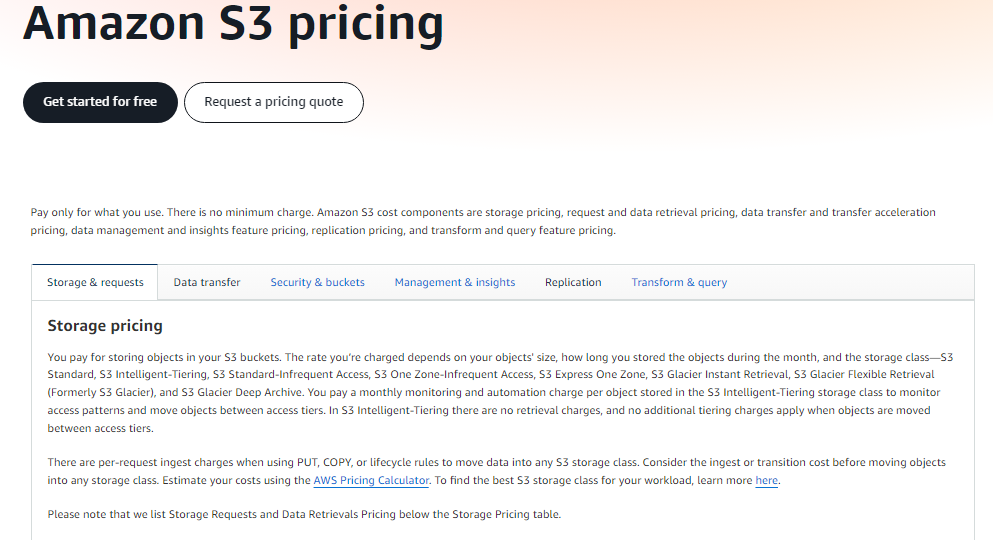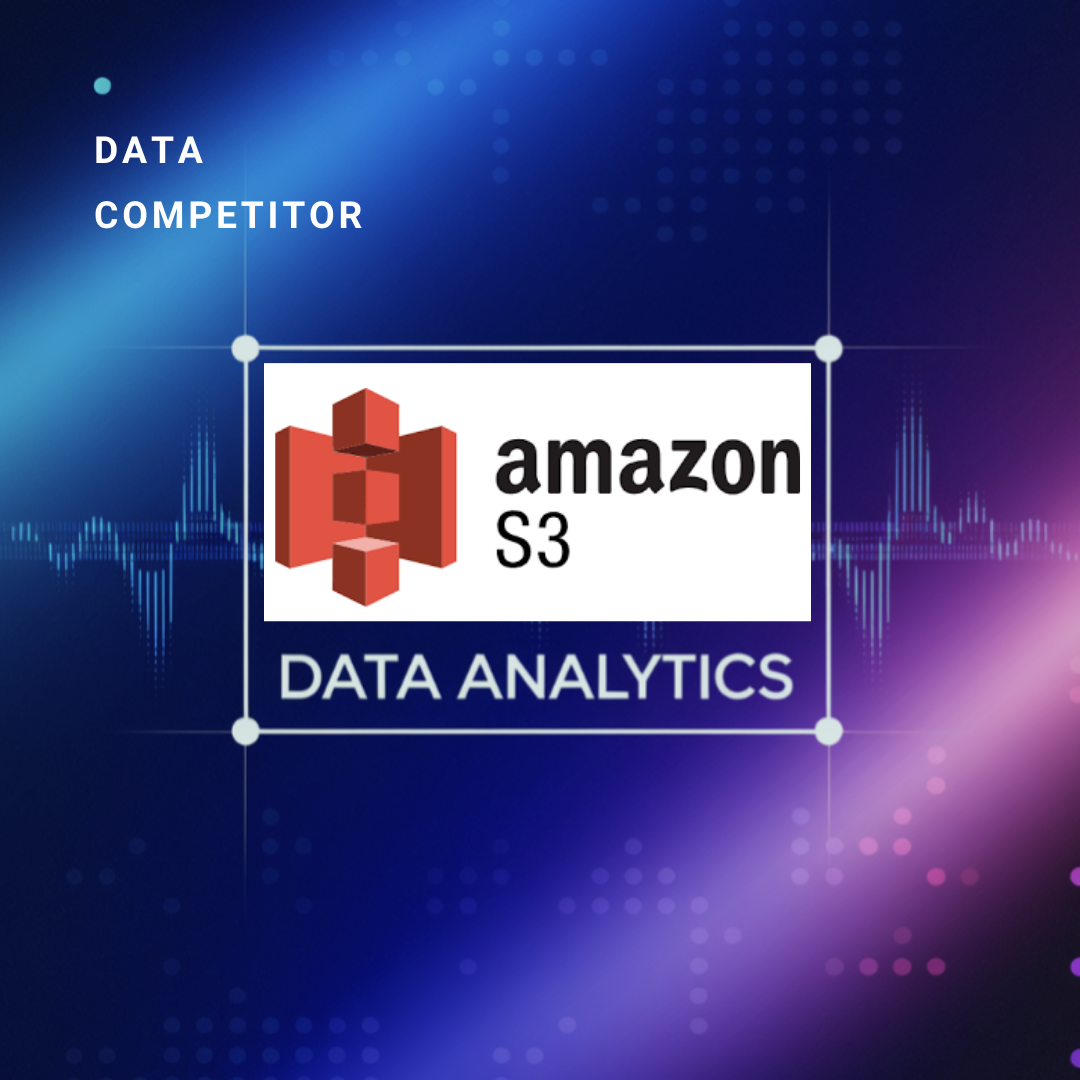Many businesses face the challenge of managing large volumes of information. How can you ensure your data is secure and easily accessible while being able to analyze it effectively?
Amazon S3 offers a robust solution for businesses looking to store, transfer, and analyze their data with unmatched flexibility. Whether you’re dealing with discrete data, large media files, or complex data collection methods, Amazon S3’s vast array of features—like data transformation and querying tools—can meet your unique needs. This article explores the core benefits and some potential drawbacks of Amazon S3 for those seeking an all-in-one marketing analytics tool.
Amazon S3 Functionality
Amazon S3 has several features tailored for versatile data management, high-performance storage, and analytics. The core features include:
- High Availability: S3 offers 99.999% availability. You have a choice of multiple storage classes to fit your needs.
- Scalable Storage: Unlimited data capacity supports both discrete and continuous data types. It is ideal for various data collection methods and forms of media.
- Integrated Analytics: You can analyze data directly in S3 for SEO analytics or search engine ranking reports with Amazon Athena and integration options for marketing analytics tools like AWS QuickSight.
- Intelligent Tiering: Automatically moves data between storage tiers based on access frequency to optimize costs while ensuring quick access when needed.
- Data Transfer Acceleration: S3 Transfer Acceleration speeds up global uploads, ideal for large datasets and geographically distributed teams.
- Amazon S3 Versioning: This feature helps you keep multiple variants of the same object in a bucket. By enabling S3 Versioning, you can preserve, retrieve, and store different versions of stored data, helping you protect or recover from accidental data losses.
- Lifecycle Management: This feature lets you define the rules for transferring objects between different storage classes or deletions as needed. For example, you may set a rule to automatically move account access logs from S3 Standard to S3 Glacier for archiving every six months to save on storage costs.
Amazon S3 Data Transfer

Amazon S3 simplifies data transfer and allows you to extract different types of media. It has features like Transfer Acceleration that can speed up any data transfer, with good results in continuous vs discrete datasets.
Here are the steps for data transfer using Amazon S3:
- Log in to the AWS Console, go to S3, and create a bucket. Configure its permissions and regional settings as needed.
- In the bucket’s properties, turn on “Transfer Acceleration” to enhance upload speeds, especially for global users.
- Use the AWS CLI, SDK, or the console to upload your files directly from your data collection methods to the S3 bucket.
- Track upload progress using Amazon CloudWatch to identify and resolve potential bottlenecks.
There is no difference between discrete and continuous data transfer processes. Once you set it up, it automates the extraction process.
Amazon S3 Reporting

Amazon S3 simplifies reporting and analytics by integrating seamlessly with tools like Amazon Athena and AWS CloudTrail. With Athena, users can query S3 data using SQL, which enables businesses to generate actionable insights directly from their stored datasets, whether analyzing discrete vs continuous data or tracking data collection methods. CloudTrail logs all access and activity in S3, providing detailed reports for compliance and security monitoring.
Additionally, S3 Storage Lens offers a centralized dashboard for visualizing usage patterns and optimizing storage costs. These features are crucial for managing different types of media and ensuring efficiency in tasks like SEO analytics or performance benchmarking.
Amazon S3 Customer Support
Amazon S3 offers multiple channels for customer support. Here is a breakdown of the options:
- Documentation: Extensive guides and tutorials covering topics like data collection methods and managing different types of media.
- AWS Support Plans: Range from Basic to Enterprise, all of which provide tailored access to technical support and architectural guidance.
- AWS Discussion Forums: Community-based support for troubleshooting and sharing best practices.
- Live Support: Premium plans include 24/7 chat, phone, and email support for immediate assistance.
Users appreciate the detailed documentation and quick response times, as seen in customer reviews praising the platform’s analytical intelligence tools and reliable service. Below is an example of a satisfied user’s feedback:

Amazon S3 Price Breakdown

Amazon S3’s pricing is pay-as-you-go, which offers flexibility for both small businesses and large enterprises. S3 pricing is divided into storage, requests, and data transfer charges, which vary by selected storage class. This dynamic model ensures that you only pay for what you use, as explained in the sections below.
Amazon S3 Free Trial
Amazon S3 provides a free tier as part of AWS’s Free Usage Tier so that users can explore its analytical software features without incurring costs. New users get 5 GB of standard storage, 20,000 GET requests, 2,000 PUT requests, and 100 GB of data transfer out each month for the first year.
This trial is perfect for evaluating Amazon S3’s functionality, such as testing storage efficiency and transfer speeds. You can use it with any data collection form or a few low-volume sources. It also allows you to familiarize yourself with tools like S3 bucket setup, access controls, and data collection methods. All these make it a great starting point for small-scale projects or individual use cases.
Amazon S3 Price Packages
Amazon S3’s pricing model is highly flexible, with several distinct storage and transfer options tailored to different use cases. Each package includes charges for storage, data transfer, data transformation, and querying based on usage, with the following types:
Standard Storage
Use case: Best for frequently accessed data, such as active business files or discrete data.
Pricing: You get a monthly bill based on the amount of data stored. Pricing varies by region, so it’s best to check specific AWS pricing pages for your region.
Infrequent Access Storage
Use case: Suitable for data that is accessed less frequently but needs to be readily available when required.
Pricing: Lower cost for storage, with slightly higher retrieval charges.
Glacier Storage
Use case: Ideal for long-term archiving. Used where data retrieval is rare but must be preserved securely.
Pricing: The most cost-effective option for archiving large volumes of data.
Data Transfer
Use case: Charges apply when data is transferred out of AWS to the internet or other AWS regions.
Pricing: Data transfer is free, but there are costs for transferring data out, typically calculated per GB.
Amazon Athena (for Data Transformation & Querying)
Use case: Enables users to perform data transformation and querying directly on data stored in S3 with SQL.
Pricing: Athena charges are based on the volume of data scanned per query.
Amazon S3 Customer Reviews

The customer says that the S3 offers him a secure, scalable, and cost-effective solution. We concur with the customer that the service offers this. It is also very flexible in terms of costs and choice of features to use.

S3 offers a simple infrastructure as well as scalable storage. Higher storage options offer almost unlimited storage. So, the client is right. Cloud storage offers you several opportunities to manage and manipulate the data.
Amazon S3 Pros and Cons
| Pros | Cons |
| Amazon S3 offers flexible storage options for various needs, from frequent access to long-term archiving. | The pricing can be complex for new users, particularly when considering data transfer and analytics fees. |
| S3 includes built-in encryption, access controls, and analytics tools to ensure data safety and compliance. | Unlike some cloud services, S3 doesn’t provide native backup features. |
| With multiple data replication options, S3 ensures high durability, making it ideal for mission-critical storage. | Large-scale data storage and frequent retrieval can lead to high costs. |
| S3 works seamlessly with other AWS services like Athena for querying and Glue for data transformation. | You may face a steep learning curve, especially when setting up more advanced features. |
Verdict
Amazon S3 advantages makes it one of the best big data analytics tools for solid reasons: provides you with scalable storage and robust security features and integrates with other AWS services like Athena for querying and Glue for data transformation. If you need reliable, cost-efficient cloud storage for various data types—from active files to archived data—you will find Amazon S3 especially beneficial.
However, the service’s complex pricing model and lack of native backup features may pose challenges for new users. Despite these critiques, S3’s flexibility and durability make it a top choice for enterprises dealing with large-scale data collection methods and analytical intelligence tasks.





Leave a Reply